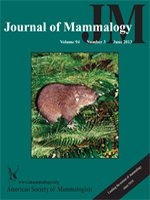Recently it was proposed that Centurio senex specializes on hard fruit because of its strong bite compared to other similar-sized frugivorous bats; however, this hypothesis has not been tested. We tested the hardness of 5 fruit species eaten by bats, including Sideroxylon capiri (Sapotaceae), here reported for the 1st time as part of the diet of C. senex. Results show that S. capiri is the hardest fruit of the species evaluated. This is the 1st evidence of C. senex eating hard fruit in the wild, which supports the theory of a skull adapted to eating hard fruit.
Recientemente se planteó que Centurio senex se especializa en frutos duros, ya que posee una fuerte mordida comparada con otros murciélagos frugívoros de talla similar; aunque no se ha probado. Pusimos a prueba la dureza de 5 especies de frutos consumidos por murciélagos, incluyendo Sideroxylon capiri (Sapotaceae), que reportamos por primera vez en la dieta de C. senex. Los resultados muestran que S. capiri es la especie con semilla más dura de las estudiadas. Esta es la primera evidencia del consumo de un fruto duro por C. senex en la naturaleza, lo cual apoya la teoría de un cráneo adaptado para el consumo de frutos duros.





